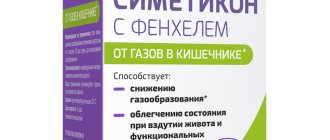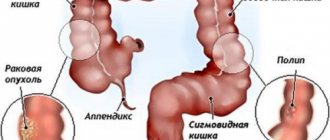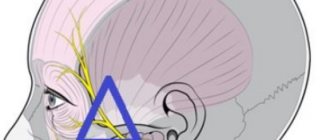Pharmacological properties
Pharmacodynamics.
Riabal selectively blocks peripheral m-cholinergic receptors of the mucous membrane of the digestive tract, bile and urinary tract and uterus. Riabal does not penetrate the geb. By selectively blocking M-cholinergic receptors, Riabal makes them insensitive to acetylcholine, which is formed at the endings of postganglionic parasympathetic nerves. The consequence of this is a decrease in the tone of the smooth muscles of the esophagus, intestines, gall bladder, bile ducts, urinary tract and uterus, as well as a decrease in the secretion of hydrochloric acid, pepsin, and exocrine activity of the pancreas. With prolonged use, Riabal does not have a negative effect on the function of the liver, kidneys, or hematopoietic tissue.
Pharmacokinetics. The drug is poorly absorbed from the gastrointestinal tract. Blood plasma clearance and renal clearance are 12.5 and 5.80 ml/min/kg body weight, respectively. T½ is 2.13 hours. It is excreted in feces and urine.
Analogs
In pharmacies you can buy many analogues of Riabal, which have a similar effect on the body. These include medications:
- But-spasm;
- Gastrofit;
- Lactovit Forte;
- Ranitidine;
- Enzistal;
- Domstal.
However, none of the drugs can completely replace the described medicine, since it contains a different set of active compounds, and also has different indications and contraindications.
Indications
Pain caused by spasms and hyperperistalsis of the digestive tract: with gastritis, gastric and duodenal ulcers, enteritis, colitis, after gastrectomy.
Pain associated with spasms and dyskinesia of the bile ducts: with cholecystitis, cholelithiasis.
Pain with pancreatitis.
Pain during urinary tract spasms: with stones in the urinary tract, bladder tenesmus, cystitis, pyelitis.
Prescribed before endoscopy of the stomach and gastrointestinal radiography.
Prescribed for vomiting.
Prescribed for dysmenorrhea.
Indications for use
- pain syndrome associated with increased peristalsis and spasms of the gastrointestinal tract (GIT), caused by acute inflammation of the gastric mucosa, exacerbation of chronic gastritis, gastric and duodenal ulcers, enterocolitis, irritable bowel syndrome;
- pain syndrome associated with spasms of the smooth muscles of the gallbladder and biliary dyskinesia caused by calculous cholecystitis, inflammation of the pancreas, pancreatitis;
- pain syndrome associated with spasm of the genitourinary tract caused by algodismenorrhea, urolithiasis, cystitis (inflammation of the bladder);
- pain in the epigastric region due to impaired function of the large intestine, accompanied by flatulence and symptoms of intestinal obstruction;
- vomiting, bloating, intestinal colic (spasms of smooth muscles of the gastrointestinal tract) in newborns and infants;
- organic gastrointestinal diseases, vomiting due to acute gastroenteritis, hyperthermia, intracranial hypertension, radiation therapy;
- instrumental and radiological examinations of the gastrointestinal tract (as a means of preliminary preparation before procedures).
Application
Pills. Riabal tablets are used orally. children aged 6-12 years - 15-30 mg 2-3 times a day.
Children over 12 years of age and adults - 30–60 mg 3 times a day.
For acute severe pain, adults can be prescribed 90 mg per dose. If it is necessary to use prifinium bromide at a dose of 15 mg, the drug is prescribed in the appropriate dose or in the form of syrup.
Syrup. Children under 3 months - 1 ml every 6–8 hours; 3-6 months - 1-2 ml every 6-8 hours; 6-12 months - 2 ml every 6-8 hours; 1-2 years - 5 ml every 6-8 hours; 2–6 years – 5–10 ml every 6–8 hours.
The duration of the course of treatment is determined by the doctor individually.
Instructions for use
Riabal belongs to the group of anticholinergic drugs, and is intended to eliminate or prevent spasms of smooth muscles. The high effectiveness of the product has been clinically proven, which is confirmed by consumers. In order for the medicine to really be beneficial in the treatment of intestinal colic, gas and bloating, it is recommended to take it according to the official instructions drawn up by the manufacturer.
Composition of the drug and release form
The main component of the drug, which has a fairly wide range of effects on the intestines, is prifinium bromide, a compound with pronounced antiemetic, antispasmodic, analgesic and muscle relaxant properties.
Riabal is available in several dosage forms, which means that consumers can purchase the following drugs of this brand in pharmacies:
syrup with a pleasant taste for children from birth to 12 years;- dissolvable tablets for children over 6 years of age and adults;
- injection solution for adults.
The tablets are packaged in polymer blisters of 20 pieces and contain 30 mg of active ingredient.
The syrup is available in tinted glass packaging and contains 7.5 mg of active compound per 5 ml of product. The bottle contains 60 ml of the drug.
Riabal ampoules contain 7.5 mg/ml of the active compound and are packaged in ampoules made of transparent colorless glass of a classic shape with a volume of 2 ml. They are packaged in contour packages, each of which holds 6 ampoules.
Indications for use
Riabal is prescribed if the following pathologies and/or changes in the functioning of the gastrointestinal tract occur:
- for chronic or acute gastritis;
- with peptic ulcer;
- with enterocolitis of various etiologies;
- with irritable bowel syndrome;
- for colic, including in children;
- for vomiting and nausea caused by gastroenteritis, gastritis, hyperthermia and hypertension.
In addition, the drug is widely used in other areas of medicine, except gastroenterology. Thus, with the help of Riabal, it is possible to eliminate painful symptoms resulting from spasm of the muscles of the gallbladder and its ducts, inflammation of the pancreas, cystitis, urolithiasis, and algodismenorrhea.
Mode of application
The regimen for taking the drug depends on the dosage form, age and existing problems of the patient. It is recommended to take tablets according to the following regimens:
- children over 6 years old - no more than 1 tablet per dose three times a day;
- children over 12 years old - 1-1.5 tablets per dose 3 times a day;
- adults - up to 3 tablets once in case of an acute attack of pain.
The injection solution is intended for the treatment of pain and spasms in adult patients. The recommended single dose should not exceed 1 ampoule of solution. The maximum daily dose is 90 mg, that is, 3 ampoules, and the course dose is 900 mg or 30 ampoules of solution per course.
For children under 6 years of age, Riabal is used in the form of syrup, administered orally according to the following regimens:
- from 0 to 3 months - no more than 4-5 ml of syrup per day;
- from 3 to 6 months - no less than 5 and no more than 8 ml of syrup per day;
- from 6 months to a year - no more than 10 ml per day;
- from 1 year to 2 years - no more than 20 ml per day;
- from 2 to 6 years - from 20 to 40 ml per day;
- from 6 to 12 years - from 40 to 80 ml per day.
The daily dose of syrup must be divided into three equal portions, the interval between doses of which must be at least 4 hours. The course of taking Riabal syrup for children cannot exceed 14 days.
Drug interactions
Riabal can interact with other drugs. Thus, it enhances the effect of non-narcotic analgesics and antidepressants. In addition, Riabal can enhance the effect of antihistamines and antipsychotics . If it is necessary to take them together, it is recommended to review the dosage of these drugs to avoid increased side effects.
Contraindications
Riabal is contraindicated in patients with the following diseases:
- glaucoma: symptoms may increase due to increased intraocular pressure;
- urinary disorders caused by prostatic hypertrophy: symptoms may increase because they are caused by relaxation of the detrusor muscle and contraction of the bladder sphincter muscles; acute urinary retention;
- serious heart disease: symptoms may worsen as your heart rate increases;
- paralytic ileus: symptoms may worsen as gastrointestinal motility slows;
- hypersensitivity to prifinium bromide or any component of the drug.
Side effects
From the immune system: allergic reactions, including skin rashes, itching, hyperemia, urticaria, angioedema.
From the digestive tract: nausea, vomiting, constipation, dry mouth.
From the urinary system: urinary retention.
From the organ of vision: impaired accommodation, blurred vision.
From the nervous system: headache, dizziness, weakness, tremor.
From the cardiovascular system: hot flashes, tachycardia, increased blood pressure, palpitations.
The listed adverse reactions disappear when the dose is reduced or after discontinuation of the drug.
special instructions
It is believed that anticholinergics may lead to increased intraocular pressure.
In patients with prostatic hypertrophy, anticholinergics may cause a decrease in maximum bladder pressure and an increase in maximum bladder volume, sometimes leading to increased dysuria.
Prifinium bromide should be used with caution in patients with hyperthyroidism, as they tend to have a rapid heartbeat or tachycardia, which may increase symptoms.
Riabal should be used with caution in patients with congestive heart failure as the heart rate may be accelerated and symptoms may worsen.
The drug should be used with caution in patients with ulcerative colitis, since toxic megacolon may develop.
Priphinium bromide should be used with caution in patients sensitive to high environmental temperatures, since the sweat glands and body thermoregulation are suppressed; hyperthermia may occur.
Due to the anticholinergic effect of the drug, prifinium bromide should be used with caution in elderly patients, as symptoms such as impaired visual accommodation, dry mouth or urinary problems may occur (see SIDE EFFECTS).
Use with caution in chronic lung diseases, especially in young children and weakened patients, as well as in cases of brain damage in children, Down's disease, central paralysis in children.
The preparation contains sucrose and non-crystallizing sorbitol solution (E420) as excipients. If you have an intolerance to certain sugars, you should consult your doctor before taking this medicine.
The drug Riabal, syrup, contains the dye E110, which can cause allergic reactions.
Use during pregnancy and lactation. Pregnancy: The safety of prifinium bromide in pregnant women has not been proven.
The use of the drug during pregnancy and lactation is possible only when the expected benefit to the mother outweighs the potential risk to the fetus/child.
Children. The drug in syrup form is used in children under 6 years of age; in tablet form - in children over 6 years of age.
The ability to influence reaction speed when driving vehicles or working with other mechanisms. Riabal may cause disturbances in visual accommodation, which should be cautioned in patients engaged in potentially hazardous activities requiring alertness, such as driving or operating machinery.
Release form and composition
- coated tablets: biconvex, round, sugar coated, pink (20 pcs. in blisters, 1 blister in a cardboard box);
- solution for injection: colorless transparent liquid for parenteral administration (2 ml in dark glass ampoules, 6 ampoules in a cardboard box);
- syrup: liquid of sweet caramel taste, orange color (60 ml in dark glass bottles complete with a measuring pipette, 1 set in a cardboard box).
1 tablet contains:
- active ingredient: prifinium bromide – 30 mg;
- auxiliary components: starch, lactose, povidone, magnesium stearate, colloidal silicon dioxide, croscarmellose sodium, gelatin, talc, titanium dioxide, paraffin paraffin, carnauba wax, sucrose, FD&C red dye No. 3.
1 ml of solution for injection contains:
- active ingredient: prifinium bromide – 7.5 mg;
- auxiliary components: sodium chloride, hydrochloric acid, water for injection.
1 ml of syrup contains:
- active ingredient: prifinium bromide – 1.5 mg;
- auxiliary components: glycerin, propylene glycol, sodium benzoate, sucrose, liquid sorbitol, sodium citrate, sodium saccharin, monoammonium glycyrrhizinate, liquid caramel flavor, dyes: FD&C yellow No. 6 and FD&C red No. 40, purified water.
Interactions
Priphinium bromide should be used with caution when taking the following medications simultaneously (table).
| Medicines | Signs, symptoms and treatment | Mechanism and risk factors |
| Tricyclic antidepressants (imipramine; amitriptyline). Phenothiazines (chlorpromazine). Antihistamines (diphenylhydramine) | Due to the anticholinergic effect, adverse reactions may develop (impaired visual accommodation, dry mouth, difficulty urinating) | Since prifinium bromide and these drugs have an anticholinergic effect, their effect may be further enhanced |
| MAO inhibitors | Due to the anticholinergic effect, adverse reactions may develop (impaired visual accommodation, dry mouth, difficulty urinating) | As drug metabolism slows, anticholinergic effects may be enhanced |
The anticholinergic effect of the drug can be potentiated with the simultaneous use of antihistamines, tricyclic antidepressants, neuroleptics of the group of phenothiazine derivatives, and disopyramide.
Enhances the effect of narcotic analgesics, antidepressants, antipsychotic drugs, neuroleptics, antiparkinsonian and M-anticholinergic drugs.
Note!
Description of the drug Riabal table. p/o 30 mg No. 20 on this page is a simplified author’s version of the apteka911 website, created on the basis of the instructions for use.
Before purchasing or using the drug, you should consult your doctor and read the manufacturer's original instructions (attached to each package of the drug). Information about the drug is provided for informational purposes only and should not be used as a guide to self-medication. Only a doctor can decide to prescribe the drug, as well as determine the dose and methods of its use.
Price
The drug Riabal is relatively inexpensive, even though, depending on the name of the pharmacy chain and regions, its price fluctuates in the range of several tens of rubles or hryvnia.
Cost in Ukraine
In Ukrainian pharmacies you can buy the medicine from 27.5 to 44 hryvnia for a pack of 20 tablets.
Cost in Russia
In Russian pharmacies the drug costs an average of 280-295 rubles per pack of 20 tablets.
Video on the topic: Bloating and flatulence. Causes of the problem and how to get rid of it









